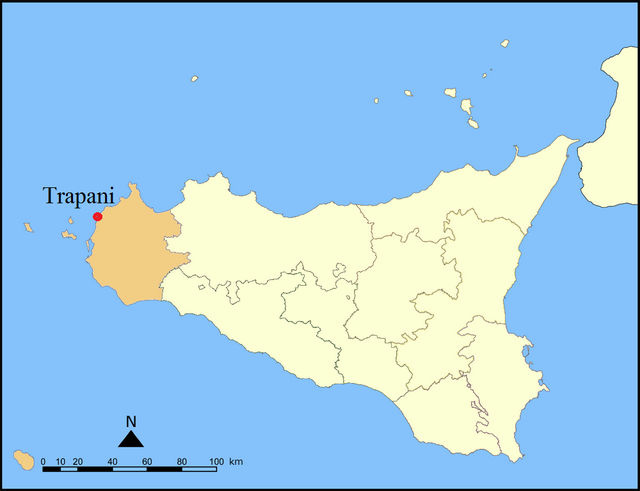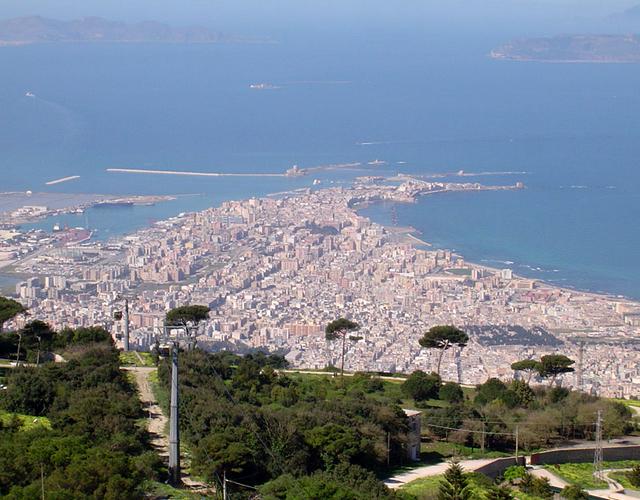
 Trapani is a port city and the capital of Trapani province in the north-west corner of Sicily, Italy. Trapani has a lively atmosphere due to its position as the capital and its economic activities as a port. It has a rich history and many historical buildings have been preserved. Old traditions are cherished. Thanks to the presence of an international airport, the city with its marina and beaches is increasingly popular as a tourist destination. The number of cruise ships calling at the city increases every year. For the individual traveler Trapani is a great base for day trips or for traveling further afield in Sicily.
Trapani is a port city and the capital of Trapani province in the north-west corner of Sicily, Italy. Trapani has a lively atmosphere due to its position as the capital and its economic activities as a port. It has a rich history and many historical buildings have been preserved. Old traditions are cherished. Thanks to the presence of an international airport, the city with its marina and beaches is increasingly popular as a tourist destination. The number of cruise ships calling at the city increases every year. For the individual traveler Trapani is a great base for day trips or for traveling further afield in Sicily.
The population of the urban area is about 90,000, including the north-eastern suburb of Casa Santa, which is not part of the comune (municipality) of Trapani.
The history of Trapani (Greek: Drépanon, Roman: Drepanum) is as old as Greek mythology. As early as the 13th century BC, the Elymians, who had settled in Erice and Segesta, used Trapani as a natural harbor. The Phoenicians expanded the city in the 9th century BC. In 260 BC, the Carthaginians used the port as a base. Two major battles took place here. In 249 BC the Romans were defeated by the Carthaginians. Eight years later it was the turn of the Romans, who defeated the Carthaginians. The Romans had little interest in the city. In the tenth century CE, under the Emirate of Sicily, Trapani regained importance and revived. The Arabs fortified the city walls and improved trade relations whereby salt had an important role. It was sold to Italy, France and England. Arab architecture still determines for a large part the cityscape of Trapani. The Normans conquered the city in 1077 and turned it into a prosperous free port. Charles I of Anjou put heavy loads on to the people who successfully rebelled in the 1282 Sicilian Vespers. The city passed under the Kingdom of Aragon and grew. In 1817 Trapani became a provincial capital. During World War II, the city suffered greatly. Heavy bombing destroyed the San Pietro district, the oldest part of the city, including the Garibaldi Theatre.
- The magnificent Basilica-Sanctuary of Maria Santissima Annunziata (also called Madonna di Tràpani) was built in 1315-1332 and rebuilt in 1760. It houses a marble statue of the Madonna of Tràpani, which might be the work of Nino Pisano
- The Baroque Palazzo della Giudecca or Casa Ciambra
- The Fontana del Tritone (Triton's Fountain)
- The Baroque Palazzo della Giudecca or Casa Ciambra
- The Cathedral (1635)
- The fine buildings on the main Corso Vittorio Emanuele
- Museo regionale Agostino Pepoli, Via Conte Pepoli, 200, +39 092 355 32 69. M-Sa 09:00-13:30, 15:00-19:30; Su 09:00-12:30. One of the main Sicilian museums. Coral art, decorative arts, gallery, painting, sculpture, jewelry and religious art including masterful cribs. €6.
- Museo di Preistoria e del Mare, Torre di Ligny, Via Torre di Ligny (in the lighthouse at the end of the spit in the old town, +39 092 354 79 22. The museum is inside the 17th-century Tower of Ligny. The museum has two sections: the preserved prehistoric artifacts from the territory of Trapani (archaeological section) and objects discovered in the seabed: amphorae, anchors, ornaments of ancient Greek, Roman and Punic (sea section). The most significant piece is a helmet shell, dating from the first Punic War (241 BC). Visitors are also allowed out on the roof to enjoy the stunning views and splendid panorama of the Gulf of Trapani, overlooked by Mount Erice.
- Museo del Sale, Via Chiusa Nubia, Paceco, +39 092 386 71 42. A fully working salt pan and mill until the 1964 floods, the Museo Ristorante "Trattoria del Sale" is a semi-working museum that informs visitors about the age old Trapani tradition of salt production and refining. Preserved equipment and exhibitions depict how the job was done before the arrival of modern machinery. Attached is a small restaurant that makes use of the salt in its recipes.
- Enjoy the bustle of the port. See the Italians shouting and gesticulating as they load the large ferries to Tunis.
Museo regionale Agostino Pepoli, Via Conte Pepoli, 200, +39 092 355 32 69. M-Sa 09:00-13:30, 15:00-19:30; Su 09:00-12:30. One of the main Sicilian museums. Coral art, decorative arts, gallery, painting, sculpture, jewelry and religious art including masterful cribs. €6.
Museo di Preistoria e del Mare, Torre di Ligny, Via Torre di Ligny (in the lighthouse at the end of the spit in the old town, +39 092 354 79 22. The museum is inside the 17th-century Tower of Ligny. The museum has two sections: the preserved prehistoric artifacts from the territory of Trapani (archaeological section) and objects discovered in the seabed: amphorae, anchors, ornaments of ancient Greek, Roman and Punic (sea section). The most significant piece is a helmet shell, dating from the first Punic War (241 BC). Visitors are also allowed out on the roof to enjoy the stunning views and splendid panorama of the Gulf of Trapani, overlooked by Mount Erice.
Museo del Sale, Via Chiusa Nubia, Paceco, +39 092 386 71 42. A fully working salt pan and mill until the 1964 floods, the Museo Ristorante "Trattoria del Sale" is a semi-working museum that informs visitors about the age old Trapani tradition of salt production and refining. Preserved equipment and exhibitions depict how the job was done before the arrival of modern machinery. Attached is a small restaurant that makes use of the salt in its recipes.
- Lido San Giuliano beaches, Lungomare (1km north of the centre. Trapani has two main beach areas, Marausa Lido and Lido San Giuliano. San Giuliano is 20 minutes walk from the busy city centre and many of the rental apartments. It features a couple of bars, changing rooms, sun-loungers, umbrellas and lifeguard service. Parking is Pay & Display during peak months alongside the main road.
- Festilandia Parco Giochi per Bambini, Via Guttuso, 10, Paceco (Siamo a solo 40m da SS115 (Via Drago di Ferro) in Via Guttuso, +39 0923 187 04 56. Children's adventure playground for birthday parties and special events.
- The city is renowned for its Easter procession, I Misteri, when the town's guilds parade a groups of sculpted 17th-century and 18th-century religious statues through the streets in a procession lasting for 16 hours on Good Friday and Holy Saturday.
- A day excursion by boat to the Aegadian (Egadi) Islands
Lido San Giuliano beaches, Lungomare (1km north of the centre. Trapani has two main beach areas, [[Marausa]] Lido and Lido San Giuliano. San Giuliano is 20 minutes walk from the busy city centre and many of the rental apartments. It features a couple of bars, changing rooms, sun-loungers, umbrellas and lifeguard service. Parking is Pay & Display during peak months alongside the main road.
Festilandia Parco Giochi per Bambini, Via Guttuso, 10, Paceco (Siamo a solo 40m da SS115 (Via Drago di Ferro) in Via Guttuso, +39 0923 187 04 56. Children's adventure playground for birthday parties and special events.
The city is renowned for its Easter procession, I Misteri, when the town's guilds parade a groups of sculpted 17th-century and 18th-century religious statues through the streets in a procession lasting for 16 hours on Good Friday and Holy Saturday.
- Busiate Trapanesi, the local pasta, can be bought in several variations and brands.
- Salted capers (capperi al sale)
- Sea salt (cristalli di sale marino) from Trapani.
- Wine (vino) from the region, such as Grillo, Inzolia en Nero d’Avola
Busiate Trapanesi, the local pasta, can be bought in several variations and brands.
Salted capers (capperi al sale)
Sea salt (cristalli di sale marino) from Trapani.
Wine (vino) from the region, such as Grillo, Inzolia en Nero d’Avola
The kitchen of Trapani has undergone many foreign influences in particular from the Arabs. Meat and pasta are often replaced by fish and couscous. A local specialty is couscous Imperiale, steamed semolina with fish stock. The pesto alla Trapanese is a raw herb sauce of tomatoes, almonds, basil and garlic. The traditional shape of the pasta is busiate, a kind of twisted macaroni.
- Calvino, Via Nunzio Nasi 77, +39 0923 21464. Excellent pizza - you'll have to come early or book ahead if you want to eat in. The locals flock here for take-aways.
- Da Salvator Via Nunzio Nasi. Fairly good, cheap food.
- Trattoria Ai Solito Posto, Via Orlandini 30. A trattoria serving traditional Trapanese cuisine. Comes highly recommended in the slow food guide to Italy. The spaghetti with sea urchins (ricci) and timballo of sardines are incredible.
Calvino, Via Nunzio Nasi 77, +39 0923 21464. Excellent pizza - you'll have to come early or book ahead if you want to eat in. The locals flock here for take-aways.
Da Salvator Via Nunzio Nasi. Fairly good, cheap food.
Trattoria Ai Solito Posto, Via Orlandini 30. A trattoria serving traditional Trapanese cuisine. Comes highly recommended in the slow food guide to Italy. The spaghetti with sea urchins (ricci) and timballo of sardines are incredible.
- Bar Coffee Time, Corso Vittorio Emanuele, 39/41, +39 09 232 33 85.
- TorrePali webcafè, Via Ammiraglio Staiti, 73, +39 09 232 55 32.
Bar Coffee Time, Corso Vittorio Emanuele, 39/41, +39 09 232 33 85.
TorrePali webcafè, Via Ammiraglio Staiti, 73, +39 09 232 55 32.
- Erice is well worth a visit. Regular buses go to this nearby precipitous hilltop town, but the best way to get there is by the new cable car. Wander around and soak in the atmosphere.
- The Aegadian (Egadi) Islands (Favignana, Levanzo and Marettimo) are very close and well worth a visit, with their wonderful beaches and bays.
- San Vito lo Capo is a wonderful beach 40 km from Trapani, with white sand and crystal blue sea.
- Visit the Greek temple, theatre, and ruins at Segesta on a day trip, or en route to Palermo.
- The beaches of Scopello are not to be missed (featured at the end of the movie Ocean's Twelve).
- The long sandy beaches of lido di Marausa and Trapani are within 9 km and 1 km of the town. There is a salt museum in Nubia on the way to Marausa, detailing the history of the salt pans in the area, and Trapani's important position on the 'Salt Road'.
- Visit Alcamo, a town founded by Arabs, where you can admire an Arab fountain, the medieval castle and the remains of an ancient village in the Mount Bonifato, in the middle of a natural reserve.
The long sandy beaches of lido di [[Marausa]] and Trapani are within 9 km and 1 km of the town. There is a salt museum in Nubia on the way to [[Marausa]], detailing the history of the salt pans in the area, and Trapani's important position on the 'Salt Road'.
